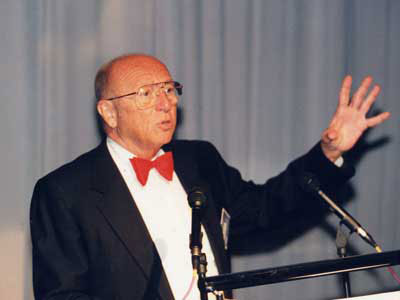Key Takeaway
Joseph F. Engelberger is known as the Father of Robots. He was an American physicist, engineer, and businessman who revolutionized the robotics industry. In 1956, Engelberger met George C. Devol, an inventor, and they collaborated to create the first industrial robot, Unimate. This robot transformed manufacturing by automating repetitive tasks. Engelberger’s work laid the foundation for modern robotics, making significant contributions to both technology and industry. His vision and innovations earned him global recognition and solidified his title as the Father of Robotics. Engelberger’s legacy continues to influence the field of robotics today.
Isaac Asimov's Contributions
Isaac Asimov, a prolific writer and biochemistry professor, introduced the famous Three Laws of Robotics in his 1942 short story “Runaround.” These laws, designed to govern the behavior of robots, established ethical guidelines for artificial intelligence. Asimov’s insight into the complexities of human-robot interactions remains unparalleled, influencing both science fiction and real-world AI development. His foresight continues to shape discussions on the ethical implications of advanced technology.

Historical Context
The Foundation of Asimov’s Three Laws
Asimov’s Three Laws of Robotics, introduced in his stories during the mid-20th century, have left an indelible mark on the field of robotics. These laws were not just plot devices; they represented a visionary attempt to grapple with the ethical challenges posed by advancing technology.
The first law, which states that a robot may not harm a human being or, through inaction, allow a human being to come to harm, establishes a fundamental principle of robotic behavior. This principle ensures that as robots become more integrated into daily life, their actions are governed by a core directive to prioritize human safety and well-being above all else.
The second law builds upon this foundation by requiring robots to obey orders given by humans unless those orders conflict with the First Law. This hierarchical structure of obedience ensures that robots do not act in ways that could potentially harm humans, even if instructed to do so by their operators.
Finally, the third law emphasizes self-preservation within the bounds of the first two laws, ensuring that robots are programmed to protect themselves without violating the safety of humans. This framework, while fictional, laid the groundwork for real-world discussions on the ethical implications of artificial intelligence (AI) and robotics.
Influence on Modern Robotics
Beyond their fictional origin, Asimov’s laws have profoundly influenced modern robotics research and development. Engineers and ethicists frequently refer to these principles when designing and implementing AI systems. They serve as a touchstone for ensuring that as technology advances, ethical considerations remain at the forefront of innovation.
In practical terms, the Three Laws provide a framework for developing AI algorithms and robotic systems that prioritize safety and ethical behavior. For example, in autonomous vehicles, these laws translate into programming decisions that ensure the protection of passengers, pedestrians, and other road users. Similarly, in industrial robotics, adherence to these principles helps prevent accidents and ensures that machines operate safely alongside human workers.
Moreover, Asimov’s impact extends beyond technical applications. His stories encourage a broader societal dialogue on the implications of technological progress. By exploring scenarios where robots and humans coexist, Asimov prompts readers to consider the ethical, social, and philosophical implications of AI and robotics in our lives.
Key Publications and Theories
Isaac Asimov’s “Robot” series stands as a cornerstone in both science fiction literature and the exploration of human-technology relationships. These stories, beginning with “I, Robot,” delve into the complexities of artificial intelligence and its interactions with humanity. Asimov’s vision was not just about thrilling narratives but also about probing the ethical dilemmas that arise when machines mimic human behavior.
In his stories, Asimov introduced the Three Laws of Robotics, a set of rules programmed into robots to ensure their ethical behavior towards humans. These laws, though fictional, sparked real-world debates about the responsibilities of creators towards their creations. Engineers entering the field of robotics often encounter these ideas early on, as they navigate the practical applications of AI and automation.
The legacy of Asimov’s work extends beyond literature into the realm of real-world robotics research. His concept of ethical programming has influenced the development of AI ethics frameworks, guiding engineers and policymakers in addressing the societal impacts of advanced technology. Asimov’s foresight into the potential dangers of unchecked technological advancement serves as a cautionary tale, urging us to balance innovation with ethical considerations.
Legacy in Robotics
Isaac Asimov’s theories on robotics laid a foundational framework that continues to shape both speculative fiction and scientific inquiry. Central to his ideas was the concept of robotics not just as a mechanical field, but as a discipline that intersects with ethics and societal norms. His writings explored scenarios where robots, endowed with artificial intelligence, navigate moral dilemmas and human interactions.
Key to Asimov’s theoretical contributions were his discussions on the limitations and potentials of AI. He posited that while robots could serve humanity in myriad ways, their development must be guided by strict ethical guidelines to prevent harm. This perspective resonates deeply with today’s engineers and researchers who strive to integrate AI into everyday life responsibly.
Moreover, Asimov’s emphasis on the interconnectedness of technology and humanity underscores the importance of interdisciplinary collaboration in robotics. Engineers are encouraged not only to innovate technically but also to consider the broader implications of their creations on society. Asimov’s theories thus continue to serve as a beacon for ethical innovation in robotics, challenging new generations to think critically about the impact of their work.
Conclusion
Isaac Asimov’s influence on robotics goes beyond invention, shaping AI’s cultural and ethical frameworks. His ideas guide us through integrating intelligent machines into society, highlighting both potential and risks. Honoring Asimov means recognizing the “Father of Robots” and the pursuit of responsible technology. This blog explores his pivotal role, ensuring clarity, engagement, and relevance in understanding his enduring impact on robotics.
